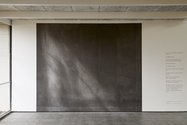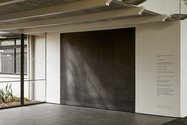John Hurrell – 3 July, 2019
The light advances to the right on a diagonal vector, pushing out from the grey rectangle's top lefthand corner. Mingled with this illusory illumination is the natural daylight penetrating the Te Tuhi building through the large lefthand glass window, and the occasional ‘hot spot' of the Te Tuhi spotlights in the middle of the top edge. The overall texture is like soft felt; the paper seems to have been lovingly caressed. It looks stroked and patted.
Auckland
Connah Podmore
This Body Also Holds Mine
9 June - 11 August 2019
Wellington artist and writer, Connah Podmore, presents a large charcoal drawing on folded paper (drawn on, rubbed in, rubbed out, and partially erased) that has been opened out and glued on to the wall.
Placed next to it is a text by the artist about the work’s origins. In her poem she incorporates fragments from virtuoso writers Maggie Nelson and Alice Notley, both quotations found in Nelson’s stunning book, The Argonauts.
The ‘body’ of the title seems to be that of her clinging sleeping baby son, whose room provides the wall on which early morning light has traversed and been subsequently rendered, but it also could be the three dimensional Te Tuhi architectural space (in which it sits) as a kind of enclosing vessel.
The light advances to the right on a diagonal vector, pushing out from the grey rectangle’s top lefthand corner. Mingled with this illusory illumination is the natural daylight penetrating the Te Tuhi building through the large lefthand glass window, and the occasional ‘hot spot’ of the Te Tuhi spotlights in the middle of the top edge. The overall texture is like soft felt; the paper seems to have been lovingly caressed. It looks stroked and patted.
In fact it looks like a blanket; nice and warm and cosy. On cold winter mornings it beckons; to get out of the draught from the nearby door you want to lift up a lower corner and slide your body underneath. To wrap the drawing and wall around you.
In a sense the piecemeal text on the right is inseparable from the adjacent (almost holiistic) charcoal drawing. It is a meditation on maternal bonding and two-way need. Both elements—with their use of cumulative process—are sort of drawings and both are kind of texts.
Maybe drawing and text are tropes for mother and son. Perhaps there is a parallel. It seems to be implied. And that light is a metaphor for bonding love—a package that brings mother, child, drawing, text, love and light all together.
John Hurrell





 Advertising in this column
Advertising in this column Two Rooms presents a program of residencies and projects
Two Rooms presents a program of residencies and projects



This Discussion has 0 comments.
Comment
Participate
Register to Participate.
Sign in
Sign in to an existing account.